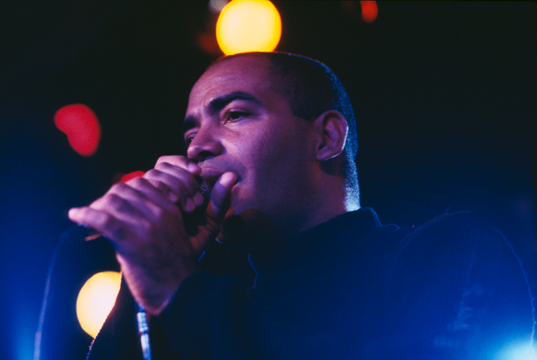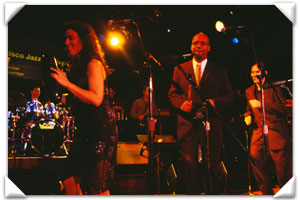Indice - Table of contents
New Stuff[hide]
Musicos: Rafael Paseiro Monzón
Musicos: Dennis Nicles Cobas
Musicos: Jiovanni Cofiño Sánchez
Musicos: Yasser Morejón Pino
Fotos: Tom Ehrlich : 2024 Monterey Jazz, P...
Resenas: Vacilón Santiaguero (Circle 9 ...
Staff: Bill Tilford
Fotos: Tom Ehrlich : 2024 Monterey Jazz, P...
Fotos: Tom Ehrlich : 2024 Monterey Jazz Fe...
Fotos: Tom Ehrlich : testing 123
Grupos: Pupy y los que S... : Discography - 1995- F...
Reportes: From The St... : Cubadisco 2...
Reportes: From The St... : Jazz Plaza ...
Fotos: Tom Ehrlich : Irakere 50th Annivers...
Photos of the Day [hide]
SpanishEnglishConc. Report - San Francisco Jazz - 2001 - Manolín Live in SF, pt. 2
The Club
The two sellouts were the first Timba shows for Bimbo's 365 Club in picturesque North Beach, San Francisco. It was not a friendly place, resulting in multiple complaints from SF's Timba regulars, but on the strength of acoustics alone, it's far and away the best Timba venue in Northern California, excluding of course Yoshi's and the Kuumbwa Jazz Center, who unfortunately almost never had Timba shows even when the bands were coming frequently. Bimbo's has a relatively low ceiling, a soft, plush, sonically-absorbent interior and a powerful and elaborate sound reinforcement system. I've been to well over 200 live Timba shows in the last few years and these two were among only a handful which were not WAY too loud and distorted. To explain this wonderful and unexpected phenomenon the soundman credited his decibel meter and skillful use of "gain structure". Unfortunately, Timba was unfamiliar territory in terms of the mix. The piano was frequently too low and even worse, the Tomás Cruz' spectacular conga-playing was buried. BUT, the vocals, horns and every subtle nuance of Guerra's drumming were brilliantly reproduced, approaching CD quality. The sound at Latin concerts is usually so horrible that the best strategy is to crowd the stage and try to bask in the groove of the direct sound from the nearest musicians. In this case, it was possible to sit two thirds of the way back and get a gorgeous stereo mix. The better than average intonation in the coros and brass indicated that the onstage monitoring was also good, although Bimbo's doesn't offer the amazing in-ear monitoring system used to such great effect by Willie Chirino and Luis Enrique. As of yet, I'm not aware of any clubs which provide these systems, so only the bands rich enough to bring along their own can use them. There's no doubt however that in-ear monitoring is the future and will drastically improve the quality of live Latin performances in the next few years as the systems become more affordable.

Manuel González Hernández, El Médico de la Salsa
The Music
Each night the band played one long set of almost 2 hours and well over a dozen songs. The band has gone against the trend of Timba towards longer and longer arrangements -- Manolín's band finishes two songs in the time it takes Issac, Paulito, or LVV to finish one. This approach is extremely effective and a major improvement over some of his Manolín's live performances in Cuba in recent years. This band's strengths are the writing, arranging, and explosive rhythm section. Unlike, for example, Mayito Rivera or Issac, Manolín doesn't have the vocal chops to improvise for extended periods of time, but in this rapid-paced format, he sounded strong and clean, by far the best I've ever heard him in concert. In Cuba in the last few years he's seemed distracted and spaced out, but now he's sharp and professional, working around his vocal limitations and maximizing the effect of his brilliant writing and warm, charismatic personality.
Keeping in the spirit of the SF Jazz Festival, the band played opened the set with a short instrumental and later played a powerful and extended Latin Jazz piece featuring solos by all the members. This was very exciting both nights and will hopefully become a regular feature of the band's shows.
The long, well-paced set included three of the best tracks from "Para Mi Gente" (1996): "Voy a Mí", "Me Pasé de Copas", and an updated version of Manolín's most famous song, "La Bola". There were four tracks from the 1997 masterpiece, "De Buena Fe": "Somos lo que Hay", "No Lo Comentes", "Él Que Esté que Tumbe", and the encore piece, "Pegaíto, Pegaíto", which also sported a great new ending. The rest of the material was post-"De Buena Fe". Although Manolín has not released an album since 1997 due to recording contract problems, he has added at least 15 strong new songs to his repertoire which are so well known in Cuba that Issac Delgado has used some of the coros (as homage) in live shows. There's a widely-circulated bootleg of some unfinished demo tracks but it's not complete and is notably missing a fantastic, fiery piece in Fmi (I don't have the correct title) which Manolín played both nights.
Manolín omitted several even newer songs which he had played in Miami this summer. This material, while strong pop, stopped short of the hard-driving Timba of his other material. Perhaps he felt the Bay Area would be more receptive to the pure Timba approach, in contrast to Miami, which at least on the surface leans towards a much more homogenized style of Latin pop. I asked keyboardist/arranger Luis Bu when we could expect the next powerhouse arrangement along the lines of "Somos lo que Hay", and he said something about Sony Records being more interested in "Pop". So where does it go from here? Manolín has managed to maintain one of the best Timba bands in the world outside of Cuba, and they continue to play unadulterated, throbbing Timba and are at least getting a reasonable amount of work doing so. But will he continue to produce more new material that's as innovative and powerful as his (released and unreleased) work of the last 6 years? That remains to be seen. Here at timba.com we'll be doing an extensive series of pages on the history and music of Manolín and his band up to this point, and may soon have some interesting "chisme" about possible future plans. For now, we can be thankful that the "Yuma" has access to at least one great Timba band, and we can continue to hope that it doesn't get watered down by the sorry state of Latin Pop currently prevailing in this country.
The Opening Act
Opening the show both nights was the Bay Area's own "Jesús Díaz y su QBA". Díaz came here from Cuba in the early 80's and quickly became one of the top congueros in the country. In QBA, he sings lead while playing the campana bell masterfully. He makes it look easy, but anyone who's ever tried this trick knows otherwise. QBA released their first album, "Caramelo", in 1999 and is about to release a second.

Jesús Díaz y su QBA
The band features the incredible Carlos Caro on timbales. Caro played for years with Paulito FG before leaving the island in the mid-90's. In addition to his work with QBA, he's the musical director of the Bay Area's other Timba band, Chambo. Another standout performer is Marco Díaz, one of the few American pianists who has risen to challenge of Cuba's advancements in montuno playing in the last decade. Díaz has mastered the "running left hand" technique popularized by Iván "Melón" González. Each hand plays a different syncopated rhythm and the result is rhythmically irresistible. At several points in the tightly-rehearsed set, bassist Saul Sierra would drop out to highlight the piano. For more information on QBA, visit their website.
The Photographer
Peter Maiden is one of the leading photographers of Latin music in the world. For more examples of his incredible work, visit his timba.com section and his website





















